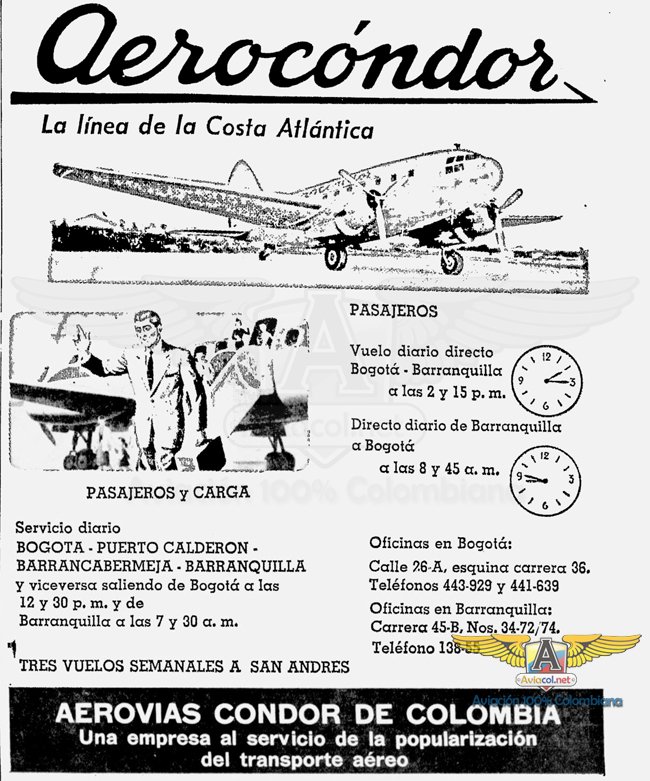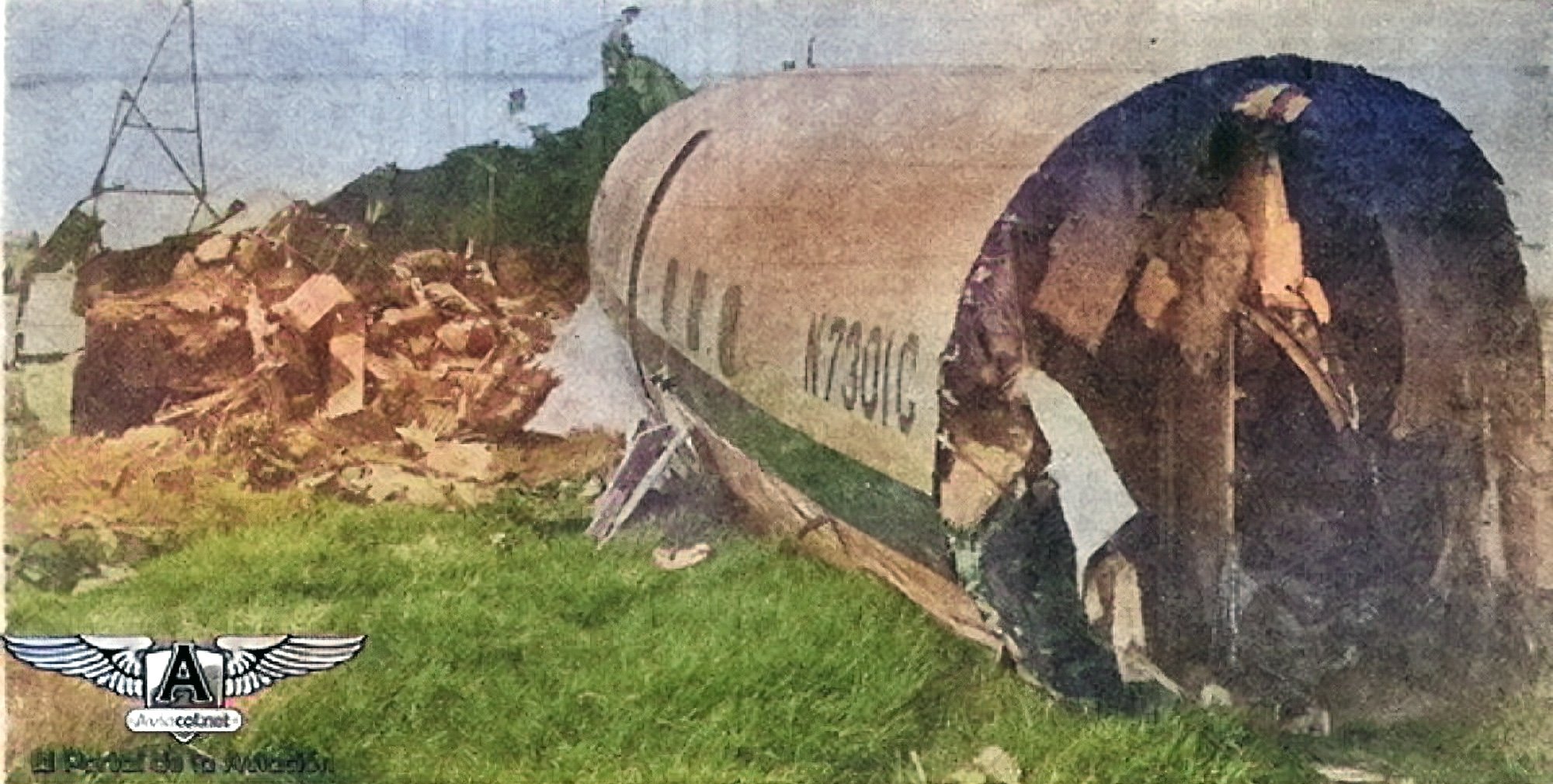Cut Corners and a Fiery Demise: The Tale of Aerocondor’s Tragic History
Image created by Aerocóndor Colombia
From the annals of Colombian aviation history, the pendulum swing of Aerocóndor’s rapid rise in fortune and equally swift demise is one of the more famous cautionary tales of Colombia’s disaster-strewn skies, which has seen 16 plane crashes that have killed 818 people since 1973. Aerocóndor was founded in Barranquilla on February 3, 1955, by six airline captains, one of whom, Julio Martín Flórez, became president of the fledgling company. Two businessmen, Luis Botero and Leonardo Mallarino, also contributed to the nascent venture.
Aerocóndor’s inaugural aircraft, a Curtiss C-46 registered as HK-400, was procured from Miami. Initially engaged in non-scheduled flights ferrying pipes for the Colombian Petroleum Company between Cartagena and Cravo Norte, Aerocóndor swiftly procured a second C-46 when the deal ended. On October 7, 1956, Aerocóndor inaugurated its first cargo flight from Barranquilla to Bogota via Barrancabermeja and Puerto Calderon.
Image created by Aviacol
The company's foray into passenger transport began in the gray, when students stranded in Barrancabermeja during a vacation period asked to board the cargo flights home. The makeshift transportation of passengers on cargo flights, who sat on their bags or stood among the cargo, formalized Aerocóndor's venture into mixed cargo and passenger flights. Eventually authorized by the Colombian Civil Aeronautics unit, these flights were outfitted with up to ten improvised seats, providing low-cost travel options that appealed to low-income students.
Image created by Aerocóndor Colombia
By January 1960, Aerocóndor had established its first exclusive passenger service, retrofitting one of the Curtiss C-46s with 48 seats to operate daily flights between Barranquilla and Bogota, via intermediate stops. Despite initially lacking ticket sales services, the new flight quickly gained traction, competing with established carriers like Avianca and Rutas Aéreas de Colombia on the same routes.
Image created by Aerocóndor Colombia
The next few years were filled with significant milestones for Aerocóndor, which expanded to service Medellín, Cali, and San Andrés, capitalizing on gaps left by the closure of other aviation companies. By 1961, Aerocóndor was transporting a record 70,500 passengers.
Image created by El Tiempo Advertising, May 1960.
Collection of Camilo Luengas.
In June 1963, Aerocóndor launched the Barranquilla-Miami route, anticipating increased demand for exports to the United States. It was the longest flight performed by C-46s at that time, with a duration of five hours and 45 minutes and an average cruising altitude of 8,000 feet. By then, the company had amassed a staff of 150 skilled mechanics and assistants.
Image created by Aerocóndor Colombia
Image created by Aerocóndor Colombia
In 1963, Aerocóndor began transporting newspapers for El Tiempo, which was eager to enhance circulation to coastal areas such as Sincelejo, and towns in Cordoba, Ciénaga, and Santa Marta. Among the newspaper cargo were “patos”, or occasional passengers– students and caravan drivers who favored travel at half the price of regular airfare. The airline also enjoyed a peculiar popularity on San Andrés Island, where islanders synchronized their clocks to their aircraft’s punctual arrivals. Aerocóndor had such cultural significance that during a local strike which blocked the airport runway, only Aerocóndor's flights were allowed to continue operations.
Image created by Bureau of Aircraft Accidents Archives
The crash of Aerocóndor's Starliner passenger craft, just 10 – 20m shy of the runway, on August 18, 1966, was the herald of Aerocóndor’s demise. The incident was attributed to pilot error, and as a consequence of fatal misjudgments in assessing the aircraft's descent and ability to land under challenging weather conditions, many onboard the flight from Miami to Bogotá– Colombians returning home for Christmas– never reunited with their families. An article in The Miami News at the time described the scene of the disaster as follows: "The plane hit short of the beginning of the runway in fog-shrouded darkness and broke up, strewing gaily wrapped Christmas packages over the ground to mingle with the wreckage of the plane and the bodies of the victims."
Image created by Bureau of Aircraft Accidents Archives
A few years later, Aerocóndor was embroiled in controversy once more, the result of another major air disaster. In 1973, its Lockheed L-188A Electra turboprop airliner crashed shortly after takeoff from Bogotá's El Dorado International Airport. The flight, bound for Curacao, ended tragically just minutes into its journey when the plane collided into the side of Cerro el Cable mountain in dense fog. All 40 individuals aboard, including four Americans, perished in the crash, and the wreckage burned for hours, according to eyewitness accounts. Investigation revealed that the flight crew deviated from prescribed departure procedures for Bogotá's runway 12, which likely led to the fatal outcome.
After a string of financial difficulties, the dissolution of Aerocóndor in 1980 marked the end of an era for Colombian aviation. Despite efforts to navigate the airline’s change in fortunes, including the return of leased aircraft and changes in ownership, the Aerocóndor ultimately succumbed to insurmountable economic challenges. Following liquidation orders on April 24, 1980, Aerocóndor ceased all operations by June 16, 1980. Despite hopes for a revival, negotiations involving pilots, liquidators, and the Colombian government failed to reach a viable solution.
The aftermath was marked by protests from former employees and pensioners who demanded remuneration on overdue payments. Over time, Aerocóndor's fleet of B707s and B720s were gradually deregistered from Colombia's civil aviation records, and with it, the final traces of the ill-fated company.










